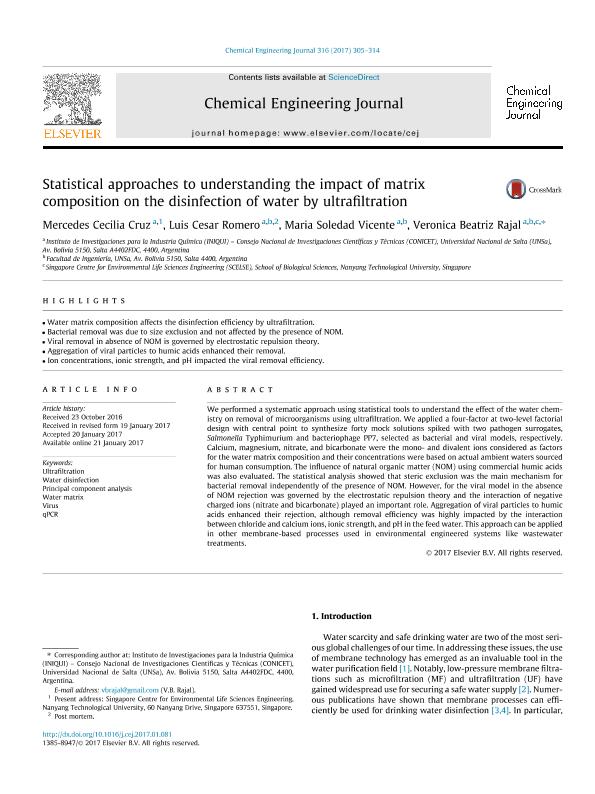Mostrar el registro sencillo del ítem
dc.contributor.author
Cruz, Mercedes Cecilia

dc.contributor.author
Romero, Luis Cesar

dc.contributor.author
Vicente, María Soledad

dc.contributor.author
Rajal, Verónica Beatriz

dc.date.available
2018-12-03T17:50:32Z
dc.date.issued
2017-05
dc.identifier.citation
Cruz, Mercedes Cecilia; Romero, Luis Cesar; Vicente, María Soledad; Rajal, Verónica Beatriz; Statistical approaches to understanding the impact of matrix composition on the disinfection of water by ultrafiltration; Elsevier Science Sa; Chemical Engineering Journal; 316; 5-2017; 305-314
dc.identifier.issn
1385-8947
dc.identifier.uri
http://hdl.handle.net/11336/65620
dc.description.abstract
We performed a systematic approach using statistical tools to understand the effect of the water chemistry on removal of microorganisms using ultrafiltration. We applied a four-factor at two-level factorial design with central point to synthesize forty mock solutions spiked with two pathogen surrogates, Salmonella Typhimurium and bacteriophage PP7, selected as bacterial and viral models, respectively. Calcium, magnesium, nitrate, and bicarbonate were the mono- and divalent ions considered as factors for the water matrix composition and their concentrations were based on actual ambient waters sourced for human consumption. The influence of natural organic matter (NOM) using commercial humic acids was also evaluated. The statistical analysis showed that steric exclusion was the main mechanism for bacterial removal independently of the presence of NOM. However, for the viral model in the absence of NOM rejection was governed by the electrostatic repulsion theory and the interaction of negative charged ions (nitrate and bicarbonate) played an important role. Aggregation of viral particles to humic acids enhanced their rejection, although removal efficiency was highly impacted by the interaction between chloride and calcium ions, ionic strength, and pH in the feed water. This approach can be applied in other membrane-based processes used in environmental engineered systems like wastewater treatments.
dc.format
application/pdf
dc.language.iso
eng
dc.publisher
Elsevier Science Sa

dc.rights
info:eu-repo/semantics/openAccess
dc.rights.uri
https://creativecommons.org/licenses/by-nc-sa/2.5/ar/
dc.subject
Principal Component Analysis
dc.subject
Qpcr
dc.subject
Ultrafiltration
dc.subject
Virus
dc.subject
Water Disinfection
dc.subject
Water Matrix
dc.subject.classification
Bioremediación, Diagnóstico Biotecnológico en Gestión Medioambiental

dc.subject.classification
Biotecnología del Medio Ambiente

dc.subject.classification
INGENIERÍAS Y TECNOLOGÍAS

dc.subject.classification
Otras Ciencias Químicas

dc.subject.classification
Ciencias Químicas

dc.subject.classification
CIENCIAS NATURALES Y EXACTAS

dc.title
Statistical approaches to understanding the impact of matrix composition on the disinfection of water by ultrafiltration
dc.type
info:eu-repo/semantics/article
dc.type
info:ar-repo/semantics/artículo
dc.type
info:eu-repo/semantics/publishedVersion
dc.date.updated
2018-10-30T18:31:34Z
dc.journal.volume
316
dc.journal.pagination
305-314
dc.journal.pais
Países Bajos

dc.journal.ciudad
Amsterdam
dc.description.fil
Fil: Cruz, Mercedes Cecilia. Consejo Nacional de Investigaciones Científicas y Técnicas. Centro Científico Tecnológico Conicet - Salta. Instituto de Investigaciones para la Industria Química. Universidad Nacional de Salta. Facultad de Ingeniería. Instituto de Investigaciones para la Industria Química; Argentina
dc.description.fil
Fil: Romero, Luis Cesar. Consejo Nacional de Investigaciones Científicas y Técnicas. Centro Científico Tecnológico Conicet - Salta. Instituto de Investigaciones para la Industria Química. Universidad Nacional de Salta. Facultad de Ingeniería. Instituto de Investigaciones para la Industria Química; Argentina
dc.description.fil
Fil: Vicente, María Soledad. Consejo Nacional de Investigaciones Científicas y Técnicas. Centro Científico Tecnológico Conicet - Salta. Instituto de Investigaciones para la Industria Química. Universidad Nacional de Salta. Facultad de Ingeniería. Instituto de Investigaciones para la Industria Química; Argentina
dc.description.fil
Fil: Rajal, Verónica Beatriz. Consejo Nacional de Investigaciones Científicas y Técnicas. Centro Científico Tecnológico Conicet - Salta. Instituto de Investigaciones para la Industria Química. Universidad Nacional de Salta. Facultad de Ingeniería. Instituto de Investigaciones para la Industria Química; Argentina. Nanyang Technological University; Singapur
dc.journal.title
Chemical Engineering Journal

dc.relation.alternativeid
info:eu-repo/semantics/altIdentifier/doi/https://dx.doi.org/10.1016/j.cej.2017.01.081
dc.relation.alternativeid
info:eu-repo/semantics/altIdentifier/url/https://linkinghub.elsevier.com/retrieve/pii/S138589471730092X
Archivos asociados
